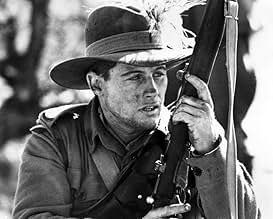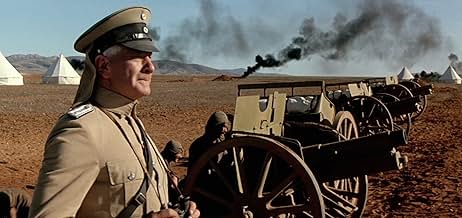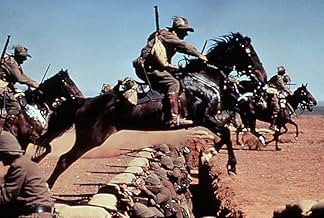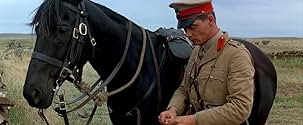CALIFICACIÓN DE IMDb
6.8/10
2.2 k
TU CALIFICACIÓN
En 1917, cuando las fuerzas británicas están empantanadas frente a las líneas turcas y alemanas en Palestina, confían en el regimiento australiano de caballos ligeros para salir del atollade... Leer todoEn 1917, cuando las fuerzas británicas están empantanadas frente a las líneas turcas y alemanas en Palestina, confían en el regimiento australiano de caballos ligeros para salir del atolladero.En 1917, cuando las fuerzas británicas están empantanadas frente a las líneas turcas y alemanas en Palestina, confían en el regimiento australiano de caballos ligeros para salir del atolladero.
- Dirección
- Guionista
- Elenco
- Premios
- 2 premios ganados y 1 nominación en total
Jack Heywood
- Dave's Dad
- (as John Heywood)
- Dirección
- Guionista
- Todo el elenco y el equipo
- Producción, taquilla y más en IMDbPro
Opiniones destacadas
A First World War Australian cavalry -- sorry, mounted infantry -- film set in the Holy Land, that's not something one tends to see every day. So, for me, the fact that, yes, the characters and situations can be a little clichéd at times is far outweighed by the novelty of the whole scenario. Quibbles are easy to put to one side.
The cavalry distinction is important. Cavalry would be armed with carbines and sabres. Mounted infantry have rifles and dismount in order to fight. This subtlety plays a part in the outcome.
A series of small skirmishes heightens tension within the film until the exciting finale, when there is a fantastic, large scale, cav ... mounted infantry charge which got my pulse racing. You'll recall something similar in David Lean's "Lawrence of Arabia". This set piece is bigger. Johnny Turk was the villain that time too.
This being an Australian Imperial Force meets the British Army sort of film, there is bound to be a little Pommy-bashing going 'round. When I lived briefly in Australia a decade ago, I found Pommy-bashing to be the single unattractive facet to the Australian national character. (The Kiwis don't do it. We like Poms here too. Pity the Dominions can't agree on that one.) So while some of the Poms in this film might be a few sheep short of a paddock, still there *is* balance, with one Pom who is much cleverer than the average. Bashing even works its way into the plot, a nice touch that.
The film does not use an excessive amount of Strine lingo -- billy, tucker -- so very little acclimatization is necessary for the uninitiated.
I can't vouch for the overall authenticity of this film. But I did notice that campaign map in the Turkish commander's office. It's labelled in Arabic only. Egypt is identified as "Misr". Geez, that is the correct Arabic name. And the Ottomans were still using the Arabic alphabet at the time. (It's Atatürk after the war who switched Turkish over to the Roman alphabet.) The thing's fair dinkum, mate. If they cared enough to get details like that right, then I'm sure that says a lot about the effort put into the film as a whole.
There is an earlier Australian film about the Light Horse I'd like to see, "Forty Thousand Horsemen" from 1940 or '41 (sources differ). Finding a copy of that film in this hemisphere though would be extraordinary, a bit like finding a North American who likes Vegemite.
The cavalry distinction is important. Cavalry would be armed with carbines and sabres. Mounted infantry have rifles and dismount in order to fight. This subtlety plays a part in the outcome.
A series of small skirmishes heightens tension within the film until the exciting finale, when there is a fantastic, large scale, cav ... mounted infantry charge which got my pulse racing. You'll recall something similar in David Lean's "Lawrence of Arabia". This set piece is bigger. Johnny Turk was the villain that time too.
This being an Australian Imperial Force meets the British Army sort of film, there is bound to be a little Pommy-bashing going 'round. When I lived briefly in Australia a decade ago, I found Pommy-bashing to be the single unattractive facet to the Australian national character. (The Kiwis don't do it. We like Poms here too. Pity the Dominions can't agree on that one.) So while some of the Poms in this film might be a few sheep short of a paddock, still there *is* balance, with one Pom who is much cleverer than the average. Bashing even works its way into the plot, a nice touch that.
The film does not use an excessive amount of Strine lingo -- billy, tucker -- so very little acclimatization is necessary for the uninitiated.
I can't vouch for the overall authenticity of this film. But I did notice that campaign map in the Turkish commander's office. It's labelled in Arabic only. Egypt is identified as "Misr". Geez, that is the correct Arabic name. And the Ottomans were still using the Arabic alphabet at the time. (It's Atatürk after the war who switched Turkish over to the Roman alphabet.) The thing's fair dinkum, mate. If they cared enough to get details like that right, then I'm sure that says a lot about the effort put into the film as a whole.
There is an earlier Australian film about the Light Horse I'd like to see, "Forty Thousand Horsemen" from 1940 or '41 (sources differ). Finding a copy of that film in this hemisphere though would be extraordinary, a bit like finding a North American who likes Vegemite.
Historically accurate and meticulously researched, this is one of the genre of "federation-era" war productions in the 1980's by the Australian film industry. The high-quality movies and mini-series of this collection included such titles as "Breaker Morant", "Gallipoli" and "ANZACS", and one can see obvious similarities in the techniques and methodology used in their production. This, however, does not detract from their appeal or their entertainment value; quite the reverse, in fact. The formula for this genre was to take an historically-documented campaign and translate it as faithfully as possible to the big screen, with emphasis on characterisation, accuracy of detail and background.
The formula works, because the characters are believable, and the situations, events and settings have been faithfully re-created. Much of the background and information for this genre came from personal diaries and military archives preserved over the years, which adds credence to the plots, the action and the stories.
"The Lighthorsemen" highlights the campaign of the Australian mounted rifles in the North Africa battleground of the Great War, and culminates with the last successful action of horse-riding troops in combat. Without giving away the story too much, the taking of Beersheba in the closing days of 1918 was a decisive event in military history, and the screen portrayal of this action will have you on the edge of your seat.
Masterful performances by Jon Blake, Shane Briant and Bill Kerr (all veterans of this movie formula,) the attention to detail, the drama, and the occasional humour make for a very entertaining movie. It's recommended viewing.
The formula works, because the characters are believable, and the situations, events and settings have been faithfully re-created. Much of the background and information for this genre came from personal diaries and military archives preserved over the years, which adds credence to the plots, the action and the stories.
"The Lighthorsemen" highlights the campaign of the Australian mounted rifles in the North Africa battleground of the Great War, and culminates with the last successful action of horse-riding troops in combat. Without giving away the story too much, the taking of Beersheba in the closing days of 1918 was a decisive event in military history, and the screen portrayal of this action will have you on the edge of your seat.
Masterful performances by Jon Blake, Shane Briant and Bill Kerr (all veterans of this movie formula,) the attention to detail, the drama, and the occasional humour make for a very entertaining movie. It's recommended viewing.
This colossal 1987 production - believe it or not - from RKO PICTURES is an Australian film closely resembling LAWRENCE OF ARABIA in its intent and rightly compared to ZULU. With a huge cast of Oz actors and directed by PHAR LAP (look it up) warhorse Simon Wincer it is basically about the last massive charge in the Middle East desert during World War One....an event still on the yearly Australian military forces roster of "Anzac" celebrations. Many other comments on this site will give you details of the history of the event and rightly applaud this lavish spectacular film. RKO Pictures had reformed with some co financing in the 80s and this is one of their few productions. BEST LITTLE WHOREHOUSE and THE BORDER are two others that spring to mind produced with Universal Pictures. With a $7 million budget and all of it on screen THE LIGHTHORSE became the last of the truly international films from Australia in the 80s. Others of this time are GALLIPOLI and CAREFUL HE MIGHT HEAR YOU and THE MAN FROM SNOWY RIVER and WE OF THE NEVER NEVER...each are films made with a lavish widescreen cinema release in mind and each huge Oz successes. THE LIGHTHORSEMEN is well worth the 140 minutes or so of carefully paced storytelling, all laced with Aussie humor and superb design and photography. The charge in the last two reels is truly breathtaking and on a cinema screen was particularly overwhelming, rivaling the battle charge in LAWRENCE OF ARABIA for sheer thrilling visuals. No CGI in this film... it is all real and scary and played and filmed for keeps. One thrill for cinema owners of the day was to have the film commence with the original cinema scope RKO logo...beeping away from the tower on top of the world. Wonderful!
Despite the ubiquitous appearance by Sigrid Thorton, and my having to eat crow over my previous comments on Anthony Andrew's acting ability (no scenery chewing or hamming it up here), I very much enjoyed this outstanding Aussie film.
Simon Wincer has directed a wide variety of films, some bad (like the Cheryl Ladd waste of celluloid "Bluegrass" and the turkey "Pharlap") and some very good (like the intense "Harlequin" and the great A&E mini "PT Barnum"). I find this one to be particularly special due to it containing one of the best war sequences on film.
Wincer and his crew have excellently interwoven a beautifully done drama with incredible special effects. The battle sequence at the end if the film is so powerful that even seen on video on an average size home TV it is astounding. Not only is the Lighthorsemen's assault wonderfully choreographed, but the reaction shots of the cast are well performed. You can see the private struggles going on in the face of the big one.
This is not a movie for the faint of heart nor should it be dismissed as just another war movie by those a little leery of the genre.
Simon Wincer has directed a wide variety of films, some bad (like the Cheryl Ladd waste of celluloid "Bluegrass" and the turkey "Pharlap") and some very good (like the intense "Harlequin" and the great A&E mini "PT Barnum"). I find this one to be particularly special due to it containing one of the best war sequences on film.
Wincer and his crew have excellently interwoven a beautifully done drama with incredible special effects. The battle sequence at the end if the film is so powerful that even seen on video on an average size home TV it is astounding. Not only is the Lighthorsemen's assault wonderfully choreographed, but the reaction shots of the cast are well performed. You can see the private struggles going on in the face of the big one.
This is not a movie for the faint of heart nor should it be dismissed as just another war movie by those a little leery of the genre.
I have watched this movie at least five times. Initially, I was a little disappointed by the tedium of the first half of the movie. I began to realize, however, that the first half of the movie is a pretty good reflection of military life prior to the second half of the 20th century: long periods of boredom and routine punctuated by major confrontations.
I've noticed that a few reviewers have remarked on the final "cavalry charge," which suggests to me that they really weren't paying much attention to the movie. The final charge on the Turkish positions is so much more awe-inspiring given the usual tactics of the Lighthorsemen. One of the most thrilling moments is when the Aussies prepare to meet the enemy on horseback and, instead of pulling out the classic cavalrymen's sabers, draw their bayonets for the charge. You almost want to laugh at the sight of 16" knives against the well-emplaced Turks.
This is one of the few war movies based on actual events that is fairly accurate, too. Take a look at some of the sites dedicated to the 4th Light Horse Briagde and you will see what I mean. A letter from one of the actual participants to his brother is an almost perfect description of the events as shown in the movie.
**** out of ***** if only for the charge
I've noticed that a few reviewers have remarked on the final "cavalry charge," which suggests to me that they really weren't paying much attention to the movie. The final charge on the Turkish positions is so much more awe-inspiring given the usual tactics of the Lighthorsemen. One of the most thrilling moments is when the Aussies prepare to meet the enemy on horseback and, instead of pulling out the classic cavalrymen's sabers, draw their bayonets for the charge. You almost want to laugh at the sight of 16" knives against the well-emplaced Turks.
This is one of the few war movies based on actual events that is fairly accurate, too. Take a look at some of the sites dedicated to the 4th Light Horse Briagde and you will see what I mean. A letter from one of the actual participants to his brother is an almost perfect description of the events as shown in the movie.
**** out of ***** if only for the charge
¿Sabías que…?
- TriviaWebsite Cinephilia reports of the Jon Blake accident and legal case: "Jon Blake was critically injured whilst driving home on December 1, 1986, after the final day's filming of The Lighthorsemen (1987). He sustained severe brain injuries and in December, 1995, the New South Wales Supreme Court ruled that Blake should be compensated for the loss of potential earnings as a star in the United States. After taking evidence from actors, directors, and film critics who indicated his career could have been as big as Mel Gibson's, the court awarded him $32 million in damages. This was later reduced to $7 million after the defence appealed."
- ErroresAt the rest camp just after the 2 soldiers pass the British Major and addresses the Colonel about the men wearing shorts at the end the Colonel calls the Major 'Sir', this wouldn't happen as a Colonel is a higher rank to Major.
- Versiones alternativasUK versions are cut by 6 secs to remove cruel horsefalls.
- ConexionesEdited into The Young Indiana Jones Chronicles: Palestine, October 1917 (1993)
- Bandas sonorasAUSTRALIA WILL BE THERE
Music and lyrics by W.W. 'Skipper' Francis
By Arrangement with Allans Music (Australia) Pty. Limited
Selecciones populares
Inicia sesión para calificar y agrega a la lista de videos para obtener recomendaciones personalizadas
- How long is The Lighthorsemen?Con tecnología de Alexa
Detalles
- Fecha de lanzamiento
- País de origen
- Sitios oficiales
- Idioma
- También se conoce como
- The Light Horse Men
- Locaciones de filmación
- St. Kilda, Melbourne, Victoria, Australia(beach, Mediterranean Sea)
- Productoras
- Ver más créditos de la compañía en IMDbPro
Taquilla
- Presupuesto
- AUD 10,500,000 (estimado)
- Total en EE. UU. y Canadá
- USD 33,779
- Fin de semana de estreno en EE. UU. y Canadá
- USD 23,645
- 10 abr 1988
- Total a nivel mundial
- USD 34,514
- Tiempo de ejecución
- 2h 11min(131 min)
- Mezcla de sonido
- Relación de aspecto
- 2.35 : 1
Contribuir a esta página
Sugiere una edición o agrega el contenido que falta




























